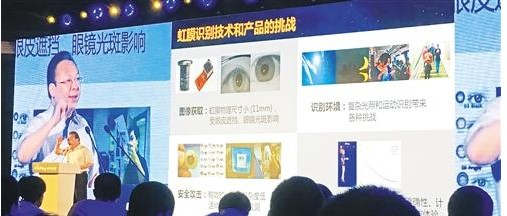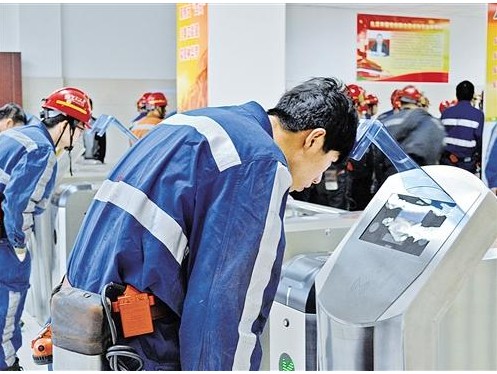With the introduction of Face ID in iPhone X, biometric recognition represented by face recognition, suddenly ushered in the "splendid scenery" of "thousands of pear blossoms" overnight.
Not long ago, Megvii Technology (Face++) announced that it has received US$460 million in Series C financing. Coincidentally, SenseTime recently announced that it has received US$620 million in C+ round financing. Fingerprints, iris, palms, veins... When a variety of biometric identifications have emerged one after another, the era of passwordless is approaching.
"Afghan Girl"
With the help of iris recognition technology, after 17 years, the photographer found the "Afghan girl" with green eyes among thousands of people claiming to be the protagonist of the photo.
At the 2018 Zhongke Hongba product launch conference held not long ago, Tan Tieniu, an academician of the Chinese Academy of Sciences and founder of Zhongke Hongba, once again told the story that once touched people's hearts-"Afghan Girl".
In the 1980s, a photo was published on the cover of National Geographic magazine. The protagonist in the photo was an Afghan girl with green eyes. However, in the face of this world-famous face, no one knows who she is. After 17 years, the photographer suddenly had the idea of ​​looking for a mysterious girl. After several twists and turns, he finally found her among thousands of people who claimed to be the protagonist of the photo with the help of iris recognition technology.

The eyes are the windows of the soul and the sign of identity. The iris is a circular part located between the black pupil and the white sclera on the surface of the human eye. It contains many intertwined spots, filaments, crowns, stripes, crypts and other detailed features. "In many cases, the iris may be the only biological feature that can identify an identity. A series of international studies have shown that iris recognition is currently the safest and most accurate identification." Tan Tieniu said.

According to the data provided by Liu Yao, former director of the Physical Evidence Appraisal Center of the Ministry of Public Security and academician of the Chinese Academy of Engineering, the false recognition rate of iris recognition can be as low as one in a million compared with 0.8% for fingerprints and 2% for face recognition.
Throughout the development history of the world, identification technology has always been an important subject that mankind has devoted to research for a long time. Early recognition technology was mainly through manual comparison-based on experience to compare samples and samples; and with the continuous development of computer technology, biometric recognition represented by finger prints, footprints, human faces, irises, voice prints, etc. Technology is becoming more mature.
Among them, fingerprints are the oldest biometric identification technology. In 1892, an Argentine police officer used a blood fingerprint at the crime scene to crack the case of Francesca's murder of a parent and child. This was the world's first case of using fingerprints to detect. At present, the total number of ten-finger fingerprints stored in the fingerprint automatic identification system of the provincial public security organs has exceeded 100 million. In recent years, the total number of cases solved by fingerprint identification systems nationwide has exceeded 100,000 per year.
Face recognition, as the name suggests, is a technology for identification based on the facial features of the human face. Due to the advantages of non-contact, no cooperation, convenient application, and conformity to people's cognitive habits, it is currently used in fields such as entry and exit management, public security identity check, and public security key population monitoring.
"Public security criminal investigation is an important application field of biometric identification." Liu Yao said that in recent years, biometric identification technology represented by fingerprints and human faces has been widely used in the field of public security, but there are still some limitations in the application process. The uniqueness and stability of iris recognition just make up for these shortcomings.
One look confirms you
The texture of the iris is unique and stable. Therefore, iris recognition has become the most accurate biometric recognition technology at present, which can identify identical twins
Iris recognition technology is to determine the identity of a person by comparing the similarity between the features of the iris image. Scientific research shows that the details of the iris ring area are finalized after one and a half years of age. It is the only internal organ that can be seen from the outside and does not have wear problems like fingerprints.
"In comparison, the iris is a biological feature that is more reliable and harder to forge than human faces and fingerprints." Tan Tieniu told the Economic Daily reporter that fingerprints are relatively easy to be imitated and forged, and face recognition will have twins, and it is difficult to distinguish between father and son. The problem. "Even if the same person changes with age, their appearance will also change. Moreover, plastic surgery, facial expressions and postures under different lighting will also affect the recognition effect." Tan Tieniu said.
Not only that, but the iris has three major characteristics: non-contact, which can be identified at medium and long distances; large capacity, fast speed, and strong real-time; anti-counterfeiting, which can realize live detection through pupil tremor. "Because the iris texture has uniqueness that is different for everyone, and the stability that remains unchanged for life after being stabilized in the infant stage, various public comparative tests and practical applications have shown that iris recognition is currently the most accurate biometric identification technology that can identify Identical twins," Tan Tieniu said.
However, it is not easy to make iris recognition easy to use, easy to use, and convenient. Tan Tieniu said that iris recognition mainly involves four key technologies: one is iris imaging technology, which solves the problem of iris image; the other is living body discrimination technology, which solves the true and false problem of iris image; the third is quality evaluation technology, which solves the quality of iris image. Good or bad question; the fourth is feature expression technology, which solves the main problem of iris image.
Take iris collection as an example. Compared with Westerners, the eyes of Chinese people are generally smaller. Many people still squint, and the other party cannot be required to keep staring at the camera when shooting. In this case, how to get the iris easily and quickly becomes a problem. This is only the tip of the iceberg. "Whether the collected iris comes from a living body, whether it comes from a glass eyeball, a photo, rather than a living person, or an artificial eye iris, a computer-synthesized iris, etc., these special circumstances need to be considered. This involves the true iris image. False question." Tan Tieniu said for example.
When foreign institutions do not provide a database for algorithm research and do not sell iris collection equipment, the Institute of Automation of the Chinese Academy of Sciences started from scratch and began research on iris recognition in China. After years of development, the Chinese Academy of Sciences has made four major leaps in iris image acquisition: from scratch, achieving zero breakthrough; achieving image acquisition from monocular to binocular; achieving image acquisition from near to far ; Realize the image acquisition from fixed to moving state.
According to the data provided by Tan Tieniu, the CASIA iris image database independently built by the Chinese Academy of Sciences is currently the most widely used iris image database in the world, and more than 16,000 scientific research teams from 180 countries have applied for use. In the study of iris feature description, Zhongke Hongba also established a general framework for iris image feature expression based on sequenced measurement, revealing the essential features of iris images, and unifying mainstream iris recognition methods.
From "brushing face" to "brushing hands"
The sudden emergence of biometric identification is ushering in the spring of development. It is estimated that in 2020, the global market size of biometric technology will reach 25 billion U.S. dollars
No bank card, no password, or even a mobile phone is needed anymore. Soon after "swipe to pay" became a hot topic, "swipe to pay" once again broke into the public eye-the large Japanese credit card company JCB announced this year to develop The mechanism of identity verification and credit card payment can be completed by scanning the palm of your hand. In the future, you only need to register your palm in the designated App to complete the record, and you can directly "swipe your hand" to complete the payment when making a payment.
"Palm geometry recognition is performed by measuring the physical characteristics of the user's palm and fingers. The vein recognition that has re-emerged in recent years is the use of vein distribution maps for personal recognition, such as the veins of the fingers, palms, and back of the hands. "Liu Yao explained.
Compared with traditional fingerprint recognition, finger vein recognition technology has a significant feature-it must be alive and have flowing blood, so the information cannot be copied or stolen; moreover, it will not be affected by wet, dirty, or damaged fingers Not available.
Recently, a commercial bank in Zhejiang launched the first batch of smart teller machines using "finger vein biometric technology". Banking operations no longer need to carry a bank card, no need to enter a password, and only need to "use your fingers." The relevant person in charge of the bank said that this technology will gradually be widely used in other scenarios such as counters in the future.
The sudden emergence of biometric identification is ushering in the spring of development. According to the statistics of the Prospective Industry Research Institute, from 2007 to 2013, the average annual growth rate of the global market size of biometric identification technology was 21.7%, and it is expected to reach 25 billion U.S. dollars in 2020, with an average annual growth rate of about 14% within 5 years.
"Faced with practical application scenarios, a single biological feature is like an'information island', and the recognition accuracy and stability will decrease. How to connect these'information islands' to realize the comprehensive integrated application and associated fusion analysis of multiple biological feature information, It is one of the future development trends." Liu Yao said that domestic and foreign research mostly focuses on the use of high-quality biometrics for identification, and many biometrics such as fingerprints, footprints, and video portraits left on-site have incomplete features. , Limited quality and other issues. "Therefore, in practical applications, how to integrate low-quality biometric data to achieve high-quality recognition is the key to future development.
Fiber Optic Distribution Box,Fiber Optic Breakout Box,Fibre Optic Breakout Box,Fibre Break Out Box
Cixi Dani Plastic Products Co.,Ltd , https://www.danifiberoptic.com